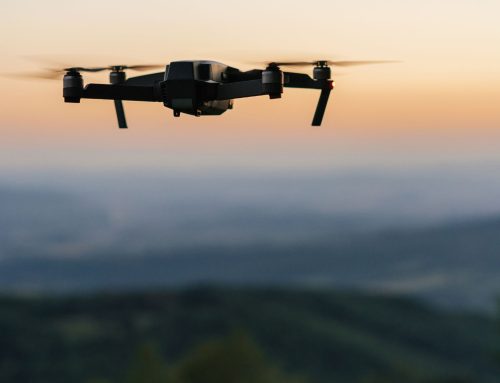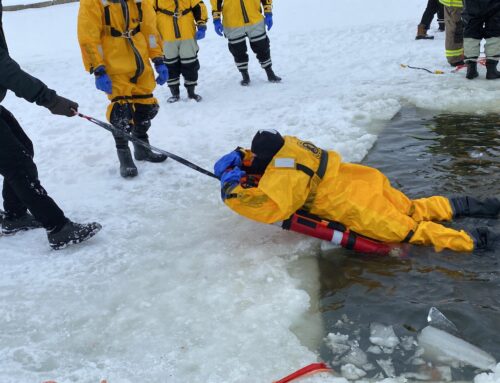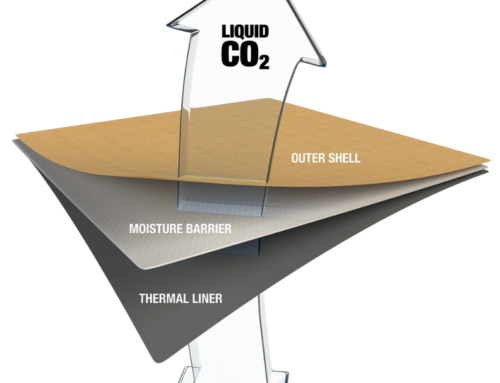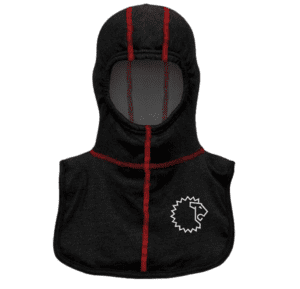

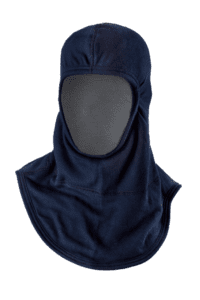
*This post is a general guide for hood cleaning considerations and may not be compatible with every manufacturer’s recommendations. Each hood manufacturer will have their own set of recommendations. Please refer to the guide provided by your manufacturer or contact your hood manufacturer for their recommendations for caring for your specific hood brand and model.*
HOOD LAUNDERING
Your hood is obviously critically important, but ironically, is also one of the most delicate parts of your PPE. Because of this, it’s super important to follow NFPA 1851 standards to launder it appropriately to avoid damage and breakdown.
For starters, it should only ever be laundered with other hoods – laundering with any of your other turnout gear can cause damage – zippers and hook snaps and hook-and-loop can all snag and reduce the lifespan of your hood. Also, heavily contaminated hoods should be washed separately to avoid cross-contaminating less soiled hoods. They should only be laundered using mild detergent with a pH between 6.0 and 10.5, in the amount specified in the manufacturer’s recommendations, using water that’s not hotter than 105 degrees F. Never use bleach or fabric softeners when laundering particulate-blocking hoods – even small amounts of chlorine will seriously reduce your hood’s protective qualities (non-chlorinated bleaches are acceptable).
HANDWASHING YOUR HOOD
Please note, some hood manufacturers may not recommend handwashing your hood. However, if no other options are available, hand washing is preferable to no washing. When laundering your hood, protect yourself first. Wear protective gloves and eye/face splash protection whenever you’re handling a contaminated protective hood that needs cleaning.
Use the following steps for cleaning your protective hood by hand using a utility sink:
- Before washing, make sure you comply with all federal, state, and local guidelines for handling effluents from utility sinks.
- Use a utility sink that’s only used for cleaning protective gear – never use a sink that is used for kitchen cleaning, personal hygiene, etc.
- Brush off loose debris.
- Apply pretreating product onto the soiled areas according to the pretreating product’s instructions on dilution and application.
- Fill sink with warm water (water must be less than 105 degrees F).
- Use mild detergent, as recommended by the manufacturer of your hood. (Remember to check that the pH of the detergent is in the proper range.)
- Presoak hood for 10 minutes.
- Gently rub the hood material together, starting with the exterior. If needed, a soft washcloth can be used.
- Drain the sink and rinse hood thoroughly.
- Repeat rinse as needed to ensure hood is clear of detergent.
- Inspect the hood for remaining spots or otherwise contaminated areas.
- If needed, repeat all wash steps – or if contamination persists, submit for further advanced cleaning procedures.
- Air dry hood by hanging in a well-ventilated area, out of direct sunlight.
- Ensure utility sink is rinsed thoroughly.
MACHINE WASHING YOUR HOOD
Hoods should never be washed with personal items, at the laundromat, or in your home washing machine. Also, as mentioned above, it’s best to only wash your hoods with other hoods. Washing with other items can cause cross-contamination and damage your hood – in addition to the risk of snagging and wear from coming into contact with zippers, snaps, etc. – washing your hood with other items made of natural fibers, like cotton, can cause fibers to become enmeshed in the hood’s fabric, increasing the potential for flaming over the hood’s surface.

- Pre-treat heavily soiled hoods
- Spot Cleaning
- Use a cleaning product that is safe for use on protective clothing fabrics to clean light spots and stains on Hoods.
- Apply the cleaner one or two times on soiled areas according to cleaning product’s instructions on dilution and application.
- Gently rub the fabrics together.
- Thoroughly and carefully rinse the hood with cool water.
- Pre-treating
- Apply pretreating product onto the soiled areas according to the pretreating product’s instructions on dilution and application.
- Thoroughly and carefully rinse hood with cool water.
- Place hood in washing machine and follow the wash procedures in this section.
- Heavily Soiled Areas
- Air dry the Hood before applying cleaning product.
- Saturate the heavily soiled and surrounding area according to the cleaning product’s instructions on dilution and application. Follow the cleaning product instructions for duration of soaking.
- Gently rub the fabrics together.
- Thoroughly and carefully rinse the Hood with cool water.
- Repeat steps B-D if necessary.
- Place the Hood into the washing machine as instructed in the wash procedures in this Section.
- Spot Cleaning
- Machine Settings
- Use a front loading extractor or front loading washing machine with a tumbling action for washing.
- Do not use a top-loading machine, because it will not wash your Hood as thoroughly, and the agitator may damage the hood and reduce its durability and protective value.
- Wash temperature should not exceed 105 degrees F (40o C).
- Use Normal Cycle.
- Use low extractor speeds less than 100 G’s.
- Double Rinse – Double rinsing removes residual dirt and insures detergent removal. If your machine will not automatically double rinse, a complete second rinse cycle should be run without adding detergent.
- Wash Procedures
- Load machine with Hoods to be washed.
- Follow machine manufacturer’s instructions for proper load size. Overloading the machine can lead to incomplete cleaning and other poor cleaning results.
- Add cleaning product per manufacturer’s instructions. Never use Chlorine bleach; non-chlorine bleach may be used.
- Ensure accurate measuring tools are used for correct amount of cleaning product.
- Set washing machine on normal cycle and start the wash cycle.
- Run an empty cycle to clean the washer after the load is completed, to prevent cross-contamination of future loads.
**Please keep in mind, the manufacturer’s recommendations for your specific hood will always supersede the basic requirements of NFPA 1851, so make sure to read the material that came with your hood and take note of anything that might differ from the norm.
DRYING YOUR HOOD
- Remove hood from washing machine, and if they are not already inside out from washing, turn them inside out to expose the inner surfaces.
- Dry by hanging in a shaded area that receives good cross ventilation or use a fan to circulate the air.
- Do not use automatic dryers because the mechanical action and excessive heat may damage or shrink your hood.
Do not hang the hood to dry in direct or indirect sunlight, or in fluorescent light. Light will severely reduce the strength of the seams, and will discolor and greatly reduce the strength and protective qualities of the components of the hood. Dry cleaning isn’t recommended due to chemicals used in the process and their purity.
Hood Inspection
INSPECTION AFTER DRYING
After ensuring that the hood is completely clean and free of hazardous materials or biological agents, begin inspection:
- Place hood on a clean surface in a brightly lit area.
- Inspection – when inspecting your hood, check thoroughly for:
- Cuts or worn areas
- Torn seams or cut threads which may allow seams to separate
- Chemical contamination which has not been removed
- Brittleness, discoloration or other evidence of damage from heat or light
- Delamination of the particulate blocking layer (inner layer)
- If your hood is excessively worn, damaged, contaminated, or otherwise do not pass inspection, do not use it. Turn in the damaged hood and obtain a replacement from your fire department. Do not attempt to repair the hood yourself.
Note: Some manufacturers have included an inspection opening in the hood that enables you to turn the hood inside out so you can easily inspect the particulate-blocking layer.
NFPA 1971 (2018) requires that particulate-blocking hoods must have a PFE of 90% or greater. The hood can have up to two breaches the size of a dime in any given panel and still maintain the 90% PFE requirement. A particulate-blocking hood must be removed from service if any of the following are found during the inspection of the hood (numbers match to image below):
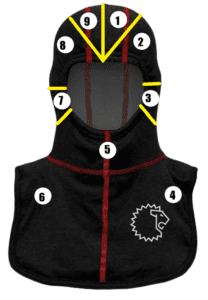
- Three or more dime-sized breaches are found in a single panel in 2, 3, 5, 7 or 8.
- Any breach larger than a dime is found in panels 2, 3, 5, 7 or 8.
- If six or more total breaches (of any size) are found in panels 2, 3, 5, 7 or 8.
Your particulate-blocking hood is a critical element of your PPE, helping to protect you from the dermal absorption of toxic byproducts of combustion. It can only do that if you keep it clean and in good repair. Take the necessary steps to clean contaminated hoods and prevent cross-contamination during laundering.
HOOD STORAGE
Finally, store your hood only when it is clean, dry and free of contamination.
- Direct or indirect sunlight or fluorescent light that could weaken or damage the materials and components (in as few as just a few days!)
- Install UV filters on fluorescent lights.
- Damage caused by exposure to light cannot be repaired, nor will manufacturers generally cover such damage in its warranty.
- Do not store anywhere that may be exposed to extreme temperatures.
- Repeated cycles of heating and cooling can reduce the protective qualities and useful life of the hood.
- Do not store hood anywhere that may retain excessive moisture.
- Failure to keep hoods thoroughly dry will result in the growth of mildew and bacteria which could lead to skin irritation, rashes, or may affect the protective qualities of the materials.
- Do not store your hood in contact with contaminants such as oils, solvents, acids or alkalis as these can damage the hood.
- Do not store hoods in air tight containers unless the hood is new and has not been issued.
- Never store your hood in your living quarters, with personal belongings, or within the passenger compartment of a vehicle.
- Prolonged exposure to contaminants remaining in the hood may increase the risk of cancer or other diseases


